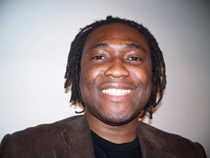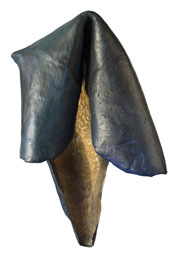The Unbearable Lightness of Being
Patrick Iberi in conversation with Vanessa Paschakarnis
Patrick Iberi: I’m glad you found time for this exchange Vanessa. Let’s start with your latest showing –Beasts and Burdens. This exhibition was hosted by Galerie Samuel Lallouz and a paragraph of the media release by Andria Minicucci examines the dichotomy between physical and metaphorical weight of your sculptures; can you please add some flesh to this?
Vanessa Paschakarnis: Minicucci writes about “reconciling the dichotomy between physical weight (beasts) and metaphorical weight (burdens).” And your question somehow goes right to the core of what making sculpture is for me. The same paragraph espouses my “exploration of the human condition”. I am trying to get at something very deep and very basic by confronting you with these sculptures that first engage you physically and then hopefully envelope you in a larger exploration that leads you to consider the metaphorical depth of meaning behind the work. In this case I am talking about the relationship of us (humans) to our inner beast, as well as to what we may consider beasts (animals) and to whom we as humans are and have been connected for a very long time in a reciprocal relationship. Sculpture for me allows for an experience and in this exhibition I tried to confront the viewer with some serious issues – “weight” if you want – that reflects on our being in the world. Physically this ended up as an exhibition with large sculptures that you encountered on various levels in regard to your body upon entering the space. This relationship of the viewer to the sculpture – the thing – on a phenomenological level is a main concern when installing an exhibition that is meant to work as an entity rather then a collection of individual works. In “Beasts and Burdens” I felt this was successful. This is the interesting and exciting part of having solo exhibitions – especially, when the individual works were originally not conceived as a coherent body of work and then open up a new thread of concerns and experiences in relation to each other.
P.I.: Is there an objectified component to your work that goes beyond the corporeal intent from yourself as the creator? How accessible is this to the viewer?
V.P.: For the first part of your question – I think there is. I am working with images that seem to be familiar, but rest unknown. You can’t really define what they are and that for me is a calling to explore beyond what you call “the corporeal intent”. My sculptures are very specifically and consciously “made”. I never work without a Marquette. So I assume that the viewer takes this into consideration – that the sculpture, that I literally confront them with, is made for a reason. People often don’t know how to look at sculpture. They think that if they don’t recognize it right away, if it doesn’t “talk” to them, they don’t get it, don’t understand it and that makes them not only disinterested, but somewhat nervous. This, of course is disappointing to me because it is where the encounter starts for me, where the engagement should begin. If an object looks like something that I think I should know but I don’t, then this hopefully makes me look a little closer and question it. This is for me the basis for an active experience as opposed to a passive reception: “Oh, I know what that is!” Every detail of my sculptures are important, as well, as the way they are placed in a room, because, as a sculpture, they do not belong, they are placed there to be considered. So you really have to ask the second part of your question to a viewer, not me. I try not to second-guess a viewer. That, for me, is a dangerous game. I propose to be honest and engaged and trust that the viewers are, too. I use certain “tools” to engage the viewer, in the language of sculpture and then hope that they get inquisitive. There is no pre-conceived answer to my work.
P.I.: The use of space is very often the basis for sculptors to incubate their moulds within themselves before anything else. Is there a limit to the size and scope of future projects? Also do you think your art addresses the continuum of space sufficiently?
V.P.: That is really not the way I deal with space. I don’t see my sculptures as existing outside of real space and in an idealized and separated space. All my forms and shapes are made to be in a relationship to and with the human body. This is even the scale that I use in regard to the drawings. I am not so much interested in the picture plane as an illusionary plane, but what interests me is what the marks and pencil lines and the scale of a shape do to a viewer in a more physical way. I think that is what people consider a sculptor’s approach to drawing; it is either maps in a relative scale, or a one to one consideration of the object in space. That said, the scope and size that I am really interested in, regarding my sculpture, works on the human level. Literally scaled to a humans reach, or just beyond in order to correspond to a body, torso, legs, arms, and the head. I often talk about wanting my viewers to “look with their knees and feel with their eyes”. For me that is right now a “limit” that I chose. Of course it does not feel like a limit, as this is a pretty wide spectrum.
I am very interested in the idea of a continuum of space; which is why, to the surprise of some people, one of my main influences for my work and thinking about sculpture, are and have always been the Minimalists. One very important exhibition in that regard is for me “Foreshadowing” from 2006. Here I am placing five amorphous forms, five shadows, in a space. The viewer becomes an object among objects, one among many. He or she has to move through a field of these sculptures. The sculptural space is the real space, these things are made in order to put the viewer in the same environment with them, share the room with you. A work like that needs a specific space. Here, it is flooded with daylight, but you can’t see out, you are immersed in the experience. This, for me, is a very exciting way of exhibiting sculpture and I was able to realize a number of exhibitions that work on that level, e.g., (Installation in a water basin,1997; New works, 1998; Ten black forms, 2000) to name a few.
P.I.: The physicality of your work especially the horned being pieces brings the naturalistic element of your sculptures to my attention. What is the idea behind this?
V.P.: I am not quite sure what you mean with “naturalistic” in this case. This is curious. Do you refer to them as looking like natural objects or found things? Or – naturalistic as in – they look like certain animals? This is in some way already the answer to your question. I am making these Horned Beings to look like something they are not, but because of that, you engage with them in a very physical way. You try and find in them the images of a particular animal (as in the titles suggested) – that really is not there. Upon closer examination you realize that these beings look like very many other things: the horns are like arms, legs, snakes, goose heads… the heads are like shells, or rocks, or bone, or skin,… you can’t define them as a specific animal.
After all, they are heads without a body. The pedestal is a placeholder that gives them a confrontational scale, a body. The surface is textured and scarred. It looks “used” and partially scraped and beaten, but overall smooth from a distance. All these are physical clues that hopefully make you question your relationship to this sculpture as a thing and the thing as conceptual other.







No Comments so far ↓
There are no comments yet...Kick things off by filling out the form below.